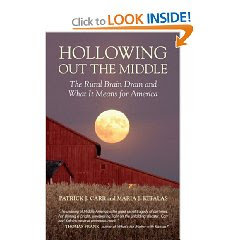
In 2001, with funding from the MacArthur Foundation, sociologists Patrick J. Carr and Maria J. Kefalas traveled to Iowa to understand the rural brain drain and the exodus of young people from America’s countryside. Articles and books -notably Richard Florida’sThe Rise of the Creative Class- celebrate the migration of highly productive and creative workers to key cities. But what happens to the towns that they desert, and the people who are left behind?
To answer that question, Carr and Kefalas moved to “Ellis,” a small town of 2,000. Ellis is typical of many small towns struggling to survive, and Iowa is typical of many states in the Heartland, aging rapidly. One reason is that many small towns simply aren’t regenerating, but another is that its educated young people are leaving in droves.
In Ellis, Carr and Kefalas met the working-class “stayers,” struggling in the region’s dying agro-industrial economy; the high-achieving and college-bound “achievers,” who often left for good; the “seekers” who head off to war to see what the world beyond offers; and the “returners,” who eventually circled back to their hometowns. What surprised them most, was that adults in the community were playing a pivotal part in the town’s decline by pushing the best and brightest young people to leave, and by under-investing in those who choose to stay, even though these young people are their best chance for a future.
The emptying out of small towns is a national concern, but there are strategies for arresting the process and creating sustainable, thriving communities. Hollowing Out the Middle is a wake-up call we cannot afford to ignore- not only because 60 million Americans still live in rural communities and small towns, but because our nation’s economic health and future is tied to the Heartland.

No comments:
Post a Comment